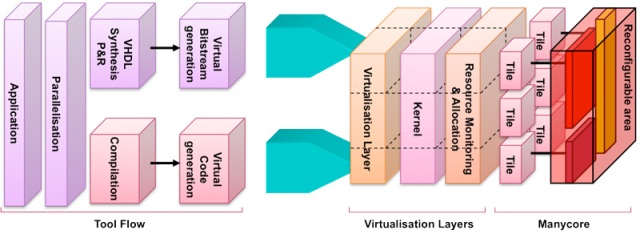Aug 13 2014
The FlexTiles project was launched in 2011 by a consortium of industries, universities and RTOs coordinated by Thales. They have joined forces to develop a programmable heterogeneous many-core platform which can be reconfigured on the fly to meet advanced processing needs such as surveillance drones or driverless cars.
With the project nearing its end (October 2014), a workshop is organized on September 1 in Munich to present results and offer a hands-on experience.
 Overview of FlexTiles approach
Overview of FlexTiles approach
A major challenge in computing is to leverage multi-core technology to develop energy-efficient high performance systems. This is critical for embedded systems with a very limited energy budget as well as for supercomputers in terms of sustainability. The efficient programming of multi-core architectures remains an unresolved issue and will be an ever greater challenge as we move towards many-core solutions with more than a thousand processor cores predicted by 2020. The FlexTiles project defines and develops an energy-efficient yet programmable heterogeneous many-core platform with self-adaptive capabilities.
The many-core platform is associated with an innovative virtualization layer and a dedicated tool-flow to improve programming efficiency, reduce the impact on time to market and reduce the development cost by 20 to 50%. FlexTiles raises the accessibility of the many-core technology to industry - from SMEs to large companies - thanks to its programming efficiency and its ability to adapt to the targeted application using embedded reconfigurable technologies.
FlexTiles is a 3D stacked chip with a many-core layer and a reconfigurable layer. This heterogeneity brings a high level of flexibility in adapting the architecture to the targeted application domain for performance and energy efficiency.
A virtualization layer on top of a kernel hides the heterogeneity and the complexity of the many-core platform from its programmer and fine-tunes the mapping of an application at runtime. The virtualization layer provides self-adaptation capabilities by dynamic relocation of application tasks to software on the many-core layer (made up of general purpose and DSP processors) or to hardware on the reconfigurable layer. This self-adaptation is used to optimize load balancing, power consumption, hot spots and resilience to faulty modules.
A FlexTiles workshop will be held on September 1 within the International Conference on Field Programmable Logic and Applications, FPL2014 www.fpl2014.org, in Munich, Germany. Registration for the workshop is separate from the conference. More information on http://flextiles.eu/WordPress3/?ai1ec_event=fpl-2014
The FlexTiles FP7, www.flextiles.eu, project is co-funded by the European Commission under the Seventh Framework Program.